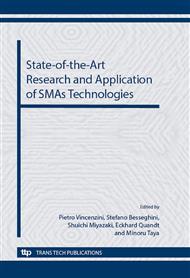[1]
S. Faehler, An introduction to actuation mechanisms of Magnetic Shape Memory Alloys, ECS Transactions, vol. 3, no. 25, pp.155-163, (2007).
DOI: 10.1149/1.2753250
Google Scholar
[2]
J. Gauthier, C. Lexcellent, A. Hubert, and J. Abadie, Modeling rearrangement process of martensite platelets in a magnetic shape memory alloy Ni2MnGa single crystal under magnetic field and (or) stress action, Journal of Intelligent Material Systems and Structures, vol. 18, no. 3, pp.289-299, (2007).
DOI: 10.1177/1045389x06066094
Google Scholar
[3]
B. Kiefer and D. C. Lagoudas, Magnetic field-induced martensitic variant reorientation in magnetic shape memory alloys†, Philosophical Magazine, vol. 85, no. 33–35, pp.4289-4329, Nov. (2005).
DOI: 10.1080/14786430500363858
Google Scholar
[4]
J. Y. Gauthier, A. Hubert, J. Abadie, N. Chaillet, and C. Lexcellent, Nonlinear Hamiltonian modelling of magnetic shape memory alloy based actuators, Sensors & Actuators: A. Physical, vol. 141, no. 2, p.536–547, (2008).
DOI: 10.1016/j.sna.2007.10.012
Google Scholar
[5]
B. Holz and H. Janocha, MSM actuators - magnetic circuit concepts and operating modes, in International Conference on New Actuators and Drives, 2010, pp.307-310.
Google Scholar
[6]
B. Holz, L. Riccardi, and H. Janocha, Compact MSM Actuator – A Concept for Highest Force Exploitation, in International Conference on New Actuators and Drives, 2012, p. (to be published).
Google Scholar
[7]
J. -M. Guldbakke, A. Mecklenburg, R. Schneider, and A. Raatz, An Air-Gap Free Disk Spring/MSMA Actuator, in International Conference on New Actuators and Drives, 2010, pp.720-722.
Google Scholar
[8]
L. Riccardi, B. Holz, D. Naso, H. Janocha, M. Laufenberg, and E. Pagounis, A simulation model for a MSM Push-Push actuator, in International Conference on Ferromagnetic Shape Memory Alloys, 2011, pp.149-150.
DOI: 10.1109/cdc.2013.6760939
Google Scholar
[9]
M. Ruderman and T. Bertram, On system-oriented modeling and identification of magnetic shape memory (MSM) actuators, in Mediterranean Conference on Control & Automation (MED), 2011, pp.1134-1139.
DOI: 10.1109/med.2011.5983103
Google Scholar
[10]
L. Riccardi, D. Naso, B. Turchiano, and H. Janocha, A precise positioning actuator based on feedback-controlled Magnetic Shape Memory Alloys, Mechatronics, p. to be published, (2012).
DOI: 10.1016/j.mechatronics.2011.12.004
Google Scholar
[11]
L. Riccardi, D. Naso, B. Turchiano, and H. Janocha, Adaptive Approximation-based Control of Unconventional Actuators, in Conference on Decision and Control and European Control Conference, 2011, pp.958-963.
DOI: 10.1109/cdc.2011.6161300
Google Scholar
[12]
P. Krejci and K. Kuhnen, Inverse control of systems with hysteresis and creep, IEEE Proceedings-Control Theory and Applications, vol. 148, no. 3, p.185–192, (2001).
DOI: 10.1049/ip-cta:20010375
Google Scholar
[13]
K. Kuhnen, Compensation of parameter-dependent complex hysteretic actuator nonlinearities in smart material systems, Journal of Intelligent Material Systems and Structures, vol. 19, no. 12, pp.1411-1421, (2008).
DOI: 10.1177/1045389x08089690
Google Scholar
[14]
R. V. Iyer and X. Tan, Control of hysteretic systems through inverse compensation, IEEE Control Systems Magazine, vol. 29, no. 1, pp.83-99, (2009).
DOI: 10.1109/mcs.2008.930924
Google Scholar


